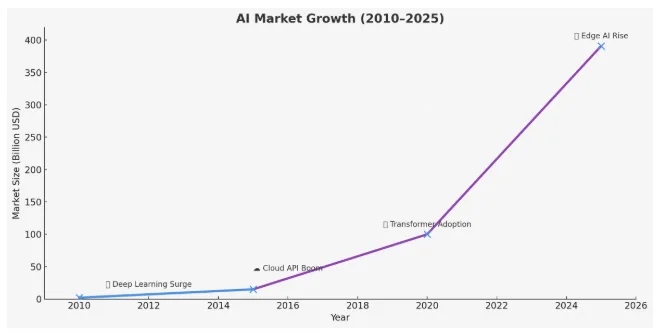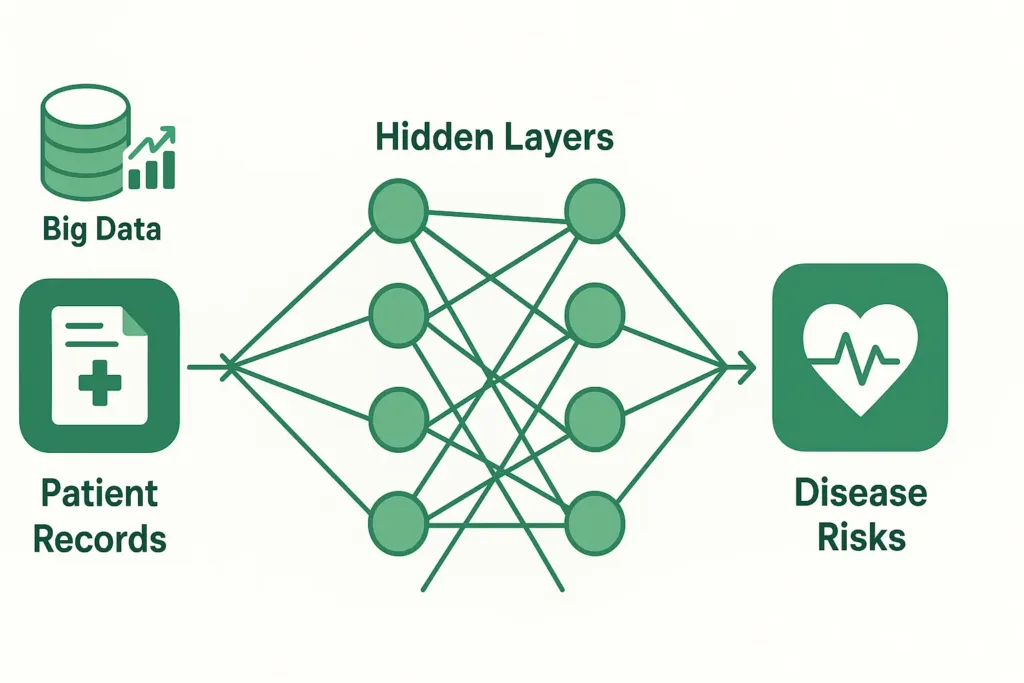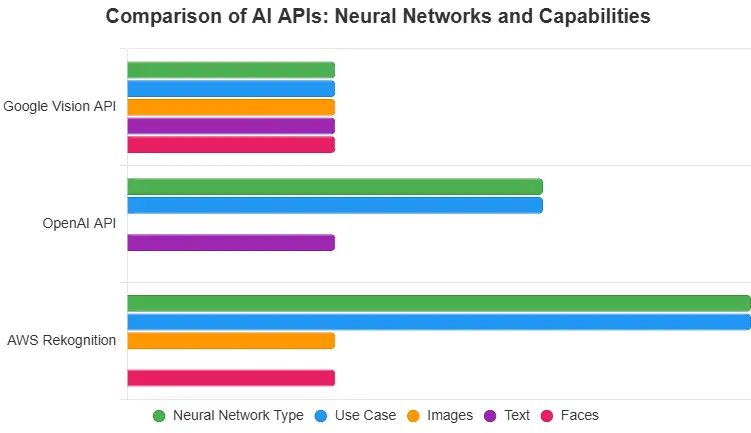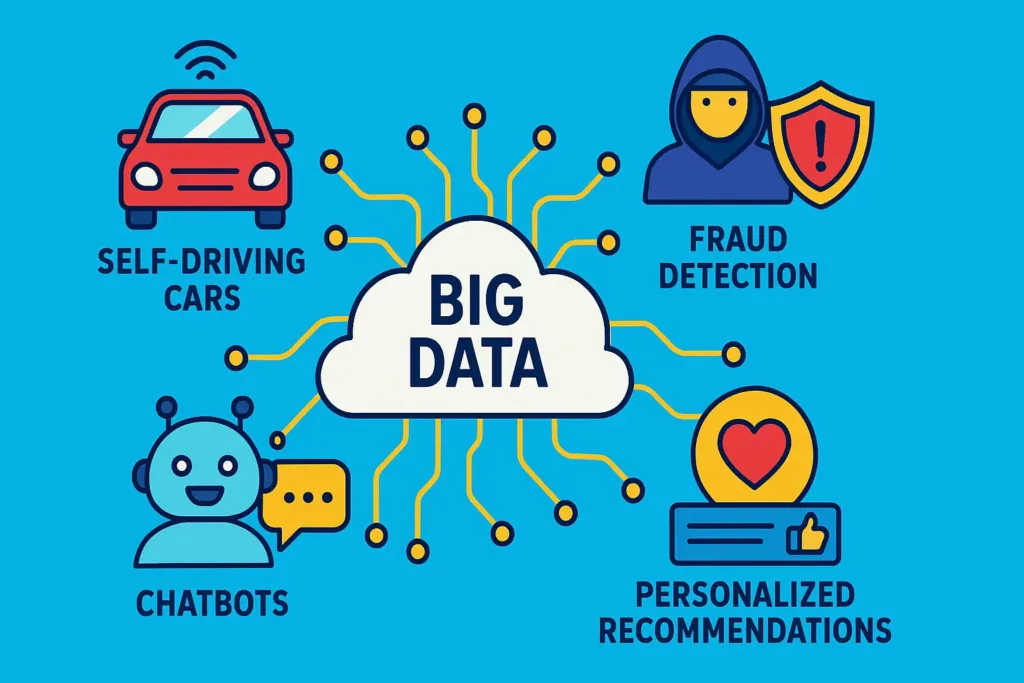My curious fellows, you must have seen artificial intelligence entering your lives over the past few years. We are now living in an era where everything is being done by machines. Whether it is face recognition, language translation, or any self-driving car, machines are being used. Artificial intelligence has completely changed our lives. According to a recent report, the global AI market exceeded $391 billion in 2025 and is expected to reach $1.81 trillion by 2030. Behind this AI revolution there is a powerful trio: neural networks, big data, and AI APIs. To put it simply, consider that a neural network acts as the brain of modern AI systems. Big data provides the fuel that digital brains use during the learning process. And finally, there are AI APIs that act as a bridge. They make it easier for the developer to tap into these smart systems. This way, developers don’t have to start the project from scratch.

The combination of these smart systems has completely transformed the industry. Neural networks, big data, and AI APIs collaborate in various fields. These range from healthcare predictions to self-driving cars. They work together to solve complex problems we could only imagine before.
If you want to learn the basics of neural networks, check out our guide: Introduction to Artificial Neural Networks. While in this article, we will learn how neural networks power big data processing and AI APIs. We will guide you about their benefits, applications, and future trends. So whether you’re a business owner, a developer, or just curious about AI, this article will help you understand why these technologies are so important.
Neural Networks & Big Data
Neural networks and big data form a strong partnership. Here is the reason this combination is so critical in modern AI.
1. Why Big Data Needs Neural Networks
When you work on a big project, traditional data analysis methods don’t work well. For example, if you are working on a project that requires terabytes of data from millions of users, simple statistical methods may not be able to find meaningful patterns. Neural networks, on the other hand, thrive on large datasets. The more data they see, the better they become at finding hidden patterns and making accurate predictions. This is why scalability makes them perfect for big data challenges.
Let me illustrate this concept to you with another example. We use social media platforms almost every day. These platforms use neural networks that can analyze the sentiment of text, detect inappropriate content, and recommend relevant posts to users. If these traditional methods had to do the same thing, they wouldn’t have been able to do it so well.
2. Examples of Large-Scale Data Processing
Here are some of the examples of large scale data processing:
- E-commerce recommendation systems look at what people buy, what they watch, and how they rate products across many users. Neural networks look for small patterns in preferences to make personalized recommendations.
- Many transactions are quickly checked by financial fraud detection systems. These systems look for unusual patterns that could show fraud, keeping banks and consumers safe.
- Weather forecast models use satellite images, sensor information, and past weather data. Neural networks help meteorologists to make better forecasts by understanding the complex relationships of weather.
3. Health Predictions using Data Analysis
Healthcare also shows how powerful neural networks are when using big data. Hospitals collect a lot of patient information every day. This includes medical records, test results, imaging scans, and many other types of important information. Neural networks look at this data to see what might happen to patients. They can find patients at risk of complications, recommend treatments, and even detect disease early.

For example, neural networks trained on many chest X-rays can detect pneumonia faster than human doctors because they have learned to see small patterns that show whether the disease is visible or not. This ability to predict helps save lives and helps reduce costs. Hospitals can act faster, avoid complications, and make better use of resources.
Neural Networks in AI APIs
AI APIs make it easy for people to use advanced neural network technology. Let’s take a look at how they work and how they’re changing software development.
1. What are AI APIs and How They Work
Let me tell you, an API (application programming interface) works like a waiter in a restaurant. You don’t need to know how the kitchen works – you just place an order, and the waiter brings your food. AI APIs work similarly. Developers can use the features of smart neural networks without knowing all the details. They send data to the API and get great answers back. These APIs run on robust cloud systems that can efficiently handle many requests and also keep costs low for users.
2. Examples of Popular AI APIs
- The Google Vision API uses advanced techniques to analyze images. It can detect objects, read text, recognize faces, and even understand emotions. Developers use it for their tasks like managing inventory and moderating content in apps.
- The OpenAI API provides advanced language capabilities to apps. It can write, summarize text, translate different languages, and answer questions. Many chatbots and writing assistants widely use this technology.
- AWS AI services offer access to tools powered by neural networks. Amazon Recognition analyzes images and videos, while Amazon Comprehend processes text to understand emotions and find entities.
- Microsoft Cognitive Services offer features such as speech, language, and image understanding. These services help developers to create more user-friendly interfaces.

How Neural Networks Allow AI APIs
Each AI API is built on the foundation of advanced neural networks. These networks learn from large data sets using powerful computer resources. Millions of examples are used to train these networks. For image recognition APIs, many labeled images are reviewed. Language APIs learn from large amounts of text from books, articles, and websites.
Once these models are ready, they are then prepared for use with APIs. This process includes making them faster and easier to use. Then, when you send a inquiry, the API processes your data, runs it through a neural network, and sends back the results. This allows developers to focus on building great apps without having to deal with the details of machine learning.
Key Benefits & Capabilities
Neural networks, merged with big data and AI APIs, offer tremendous benefits across industries. Let’s take a look at the most important benefits.
1. Accuracy Improvements
Neural networks are good at finding patterns that humans might not see. Take the example of medical imaging, where they can detect early-stage cancer more accurately than experienced doctors. They can do this because they can look at a lot of training data. While a human doctor might look at thousands of scans in his career, neural networks can study millions of images while learning. This helps them spot rare conditions and subtle symptoms that human doctors might miss. The result is more precise diagnoses and better patient care.
2. Automation Potential
Neural networks can handle complex decision-making tasks that once required human skills with great ease. Customer service chatbots answer simple questions, allowing human workers to focus on more complex problems. In factories, neural networks help with quality control by spotting defective products on assembly lines. This automation works tirelessly, and it keeps quality consistent. Banks use these systems to approve loans by looking at credit history, income trends, and risks. This way, they can process applications faster while adhering to strict lending rules.
3. Scalability in Cloud Environments
Cloud computing provides the support needed to scale neural networks around the world. Applications can automatically handle sudden spikes in traffic by using more computing power. This ability to scale is critical for today’s applications. For example, a popular social media post can get millions of requests for image recognition in just a few hours. Cloud-based AI services distribute this workload across multiple data centers, ensuring good performance no matter how high the demand. The pay-as-you-go model also provides cutting-edge AI tools for startups and small businesses that can’t afford their own systems.
Ways We Use Things in Our Daily Life
I must say that neural networks, big data and AI APIs power applications that seemed like science fiction a few years ago are now reality. Here are some examples of the transformation.
1. Self-Driving Cars
Self-driving cars, which are very popular today, also work by operating on these neural networks. These cars collect information from cameras, radar, lidar, and GPS at the same time. They use specialized networks to look at camera images and see people, signs, and road conditions. Another type of network tracks moving objects and predicts where they will go next. What to do in an emergency .
To get better, these cars need a lot of data. Companies collect millions of miles of driving data to teach their systems. Different conditions, such as busy roads or bad weather, help their technology improve. Tesla’s full self-driving system uses over 1 billion miles of real driving data to prepare for challenging conditions.
2. Fraud Detection
Banks use neural networks to prevent fraudulent transactions. These systems look closely at spending habits, where exchanges occur, and when they occur in real time. They learn what typical spending looks like for each customer. If a transaction seems unusual, the program flags it for review.
Credit card companies process millions of transactions every day. Neural networks can detect suspicious activity very quickly, stopping fraud before it happens. Machine learning models are constantly adapting to new fraud techniques. As criminals develop new methods, the networks learn to recognize these patterns and update their detection strategies.
3. Chatbots & Language Models
Modern chatbots use advanced neural networks to better understand conversations. They are changing the way customer service works. These systems learn from large amounts of text, such as books and conversations. They pick up grammar, context, and subtle meanings in human language.
AI tools make this technology easy for businesses to use. Companies can add smart language features to their apps without having to start from scratch. This leads to smoother and more helpful interactions between people and machines.

Future Trends of Neural Networks Big Data and AI APIs
The future of neural networks, big data, and AI looks bright. A few key trends will influence how the next AI evolves.
1. Better Neural Networks
Researchers are making neural networks more efficient, meaning they are creating neural networks that can do more with less computing power. Techniques like pruning remove unnecessary connections from trained networks, and quantization reduces the precision of network settings to save memory. These improvements make advanced AI features available on smartphones and other devices. They allow users to run complex networks locally without the need for cloud services. New designs like MobileNets and EfficientNets focus on low-resource environments while still being precise.
2. Low-Code AI APIs
AI development is also moving towards easier-to-use tools. New platforms allow users to build AI applications using visual tools without requiring deep programming skills. These tools simplify the construction of neural networks, allowing business users to create custom AI solutions by combining ready-made parts. AutoML platforms automatically select the best neural network designs and adjust them for specific data. This makes AI development easier for more people, accelerating its use across industries.
3. Edge AI for Real-Time Processing
Edge computing allows neural network processing to be closer to where data is created, which reduces latency and helps protect privacy. Smart cameras can analyze on-site video streams to identify security threats without sending data to cloud servers. Self-driving cars can process sensor data in real time without needing internet access. New chips are being designed to improve neural network performance at the edge. Companies like Apple, Google, and Qualcomm are embedding AI features directly into consumer devices. This trend supports new uses that require instant answers while also addressing privacy concerns related to sharing sensitive data with remote servers. The combination of edge processing and cloud AI services creates systems that balance speed, privacy, and cost.
Conclusion
Neural networks have gone from being just an idea to becoming a critical part of today’s digital world. They work behind the scenes to handle big data and power smart AI tools that are transforming many industries. This powerful combination is driving new ideas. It is creating jobs. It is solving difficult problems in fields like healthcare and finance.
There are still challenges to overcome, such as keeping data secure and managing costs, but the future looks bright. As scientists find better designs and new ways to use AI, neural networks will continue to be key to future technology. The next apps will be smarter. They will be more automated. They will also be better integrated into our daily lives. This will all be due to this important technology.
Recommended Reads for curious Minds
- AI and Machine Learning for Coders by Laurence Moroney
- Deep Learning with Python by François Chollet
- NVIDIA Jetson Orin Nano Super by Mason J. Cole
Frequently Asked Questions
Neural networks quickly handle large amounts of data. They find patterns, make predictions, and help with decision-making, making them important for big data analysis.
AI APIs use ready-made neural networks to offer AI features like recognizing images, translating languages, analyzing feelings, and giving recommendations without needing complicated setup.
Yes. Neural networks are excellent at handling unstructured data like text, images, audio, and video, which makes them perfect for real-world big data scenarios.
Healthcare, finance, e-commerce, transportation, marketing, and manufacturing all use neural networks to analyze data, predict outcomes, and improve services.
Yes. Risks include biased data, high computational costs, and the need for large datasets to achieve accuracy. These can be reduced with proper design and monitoring.




